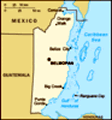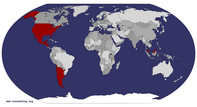Advertisement
Published: March 23rd 2009
A hard rains gonna fall
After enjoying our visit to Tikal we thought we would visit Belize as we were relatively close to the border. After a 3 hour journey to the customs office in Guatemala we were left a little lighter in our wallets after the unofficial 'tax'.
On the Belizean side after declaring our contraband banana we found we were stranded with no local transport to the nearest town or bus station and with no Belizean (or US) currency. So after catching an expensive taxi to the nearest cash machine in San Ignacio we got on our first Belizean chicken bus bound for Dangriga via Belmopan - the key difference between guatemalan and Belizean chicken buses is that in Belize only two people sit per seat rather than 4 in Guatemala.
The other immediate differences between the two countries are that the women were no longer wearing the huipile traditional dress - it was lycra all the way with lots of skin on display (some of which definitely shouldn't have been), A big contrast to the Guatemalan women's attire where it was very rare to see shoulders and legs on display.
Suddenly on every

 Oops
Oops
So good we got it in twicestreet corner there were chinese restaraunts and supermarkets and loads of signs about Taiwanese/Belizean government cooperation. The biggest surprise though was the appearance of the Mennonites who spoke an old german dialect and wore clothes straight out of the 19th century. The women wore bonnets and long, heavy green cotton dresses and the men wore breeches with braces, straw hats and beards. For some reason it appeared they didn't have to pay bus fares - but I am not too sure. Would like to find out more about these people, all theyre clothesa re hand made a nd they were picked up from the bus in a horse and cart with potatoes in the back.
Most of the rest of the people were of african descent or african mixed with something else which was quite different to most people being of Mayan origins back in Guatemala.
Of course the key difference was everyone spoke english which was weird after 2 months of spanish, the Queen was on the dollar notes and you could get Daddies brown sauce in the shops.
We were looking forward to getting to the coast and seeing the sea again. Arriving in Dangriga

 What a hunk
What a hunk
Suck that belly in!we found pretty much a one street town with not much going on, every one hanging around not up to anything in particular. We checked in to our most expensive and basic accomodation yet - a dorm sharing with some UK medical students on a work jolly and some weirdo girl who kept going to the toilet to blow her nose - OCD we thought as she slammed the door all night as she was doing it. Lets just say she wasn't the most favorite person in the room in the morning, getting fierce looks from us and the medical students.
We left town as soon as possible as Dangriga wasn't really worth staying in and after a nice breakfast of roti, red beans, eggs and hot sauce washed down with OJ and coffee at a local shack by the side if the road we jumped on another bus to Placencia.
In Placencia we decided to splash out a bit as everything was expensive anyway and rented our own little home, well a hut thing with a kitchen, bathroom, living room and bedroom. This was at a place called Lydia's Guesthouse and the hotel and Lydia herself were

 The promenade at Punta Gorda
The promenade at Punta Gorda
A brief respite from the rain. very nice.
Placencia is on a spit of land, at places only a few metres wide, there is massive development going on with the road surface being finished and loads and loads of houses, hotels and malls being built. We just thought that one big hurricane could come along and destroy it all - it is hard to understand what goes through peoples minds when they speculate on property in areas like this , who knows how they will get water for all the people who will visit and live there, let alone food and fuel etc.
Placencia town itself is still cute in a picture postcard, carribean, jah rastafari type of way with an americanised version of Jamaica sold to the tourists - all Bob marley and good vibes etc. The place was full of brightly coloured clap board houses and the local men were friendly enough - especially to the women. The friendly atmosphere seemed pretty genuine though and the local Garifuna people are very welcoming to one and all and we were made to feel pretty comforatable straight away.
The food was rice and beans with BBQ chicken mostly but I went for the
beef stew when available which was very tasty.
The beach was long with white sand and unfortunately loads of plastic rubbish washed up after the recent storm, the local beach cleaner hadn't got round to picking it all up but once he did it looked great again.
Its hard sometimes to see beautiful beaches like those in Placencia and Cozumel ruined by plastic rubbish washed ashore, the seas must be full of it - what can be done? I fear it is all too late to save the world now, there are just too many of us on earth who want a better life and the environment is going to get a lot worse than it is now before it will get any better.
We walked along the beach and took a dip in the cool water to get out of the sun, but mostly we watched telly as it started to rain. I dont mean a bit of drizzle either - this was really heavy and seemed bigger than the monsoon rains in Sri Lanka which stop after a few hours, this rain went on and on, day and night and was like stepping into a
fierce shower - instantly drenched. I was thinking that we might get flooded and our hut would float off to Cuba at one point it was so severe.
After a few days of non-stop rain we were starting to get fed up and decided to leave for Punta Gorda - another one street town with not much happening, we spent the afternoon on a dilapidated pier with the local kids who were fishing, whilst we sat gazing into distance not wanting to go back the hostel that had seen better days.
The Journey across the sea back into Guatemala's Puerto Barrios was pretty rough, big waves and rain meant we all got soaked in the speed boat/Lancha and each time the boat rose it slammed back into the sea and our spines and backsides were compacted by the hard wooden seats. Thank god we had our waterproof jackets and hoods on as some of the others in the boat got really wet and cold despite the plastic sheeting that was given out as protection from the elements.
After a short hop from Puerto Barrios we arrived in Livingstone an english speaking part of Guatemala populated by Garifunans.
Again this was probably a nice place but the rain would not stop, it wasn't as hard as before but it was pretty miserable. We did stay in a pretty decent hostal though and had a double room in a cabana to ourselves. We hung around the bar area mostly but we did do a quick mooch about town which isn't very big. We found a local restaurant that served up good quality but cheap meals and Marcel had the local speciality of Coconut fish stew that contained all manner of shellfish, prawns, crab, whole fish and plantain - some parts looked pretty disgusting but it tasted good and probably could have fed three people, it took Marcel 3 hours almost to eat it all - after which he had to go straight to bed.
Rain, rain, more rain would it ever stop? We stayed in the bar and got chatting with the other travellers, most were partaking of the local herb and chilling out - the bar manager extending the happy hours to keep us upbeat then... power cut! Pitch blackness and heavy rain, steps to navigate with matches to get to our torches in our backpacks then
back to the bar with a fridge that was getting warmer and the music more subdued now it was running on batteries. We decided we had to leave to get out of the bloody rain.
The next morning We caught a boat up the Rio Dulce to the mouth of lake Izabal at Rio Grande, the journey was along spectacular gorges covered by forest with many villages along the river accessable only by boat. We hurtled along (again in the heavy rain) with a fine mist obscuring the shoreline at the rivers widest parts. The boat stopped now and again at the touristy places that on a good day would have been quite interesting but this day most people just wanted to get to the end of the journey to get off the boat and under a roof for shelter.
We decided to stay in a Swiss place on the river, it was built from wood on stilts over the water in a delta, it looked like a swiss chalet, open plan style and was a nice place to stay.
We emptied our rucksacks that by now were saturated and almost everything inside was wet with no hope
of drying due to the humidity.MOULD wass setting in. We had a good Swiss meal talking to some good people, listening to umpah umpah music. The rain was getting depressing and what a shame because on a sunny day this was a really beautiful location to explore on the free canoes provided by the hotel, in the heavy rain we really didn't want to go paddling around.
So going west inland hadn't made much difference weather wise, we now decided to go south to hopefully more sunnier climes, we decided to go to Honduras.
Advertisement
Tot: 0.072s; Tpl: 0.012s; cc: 13; qc: 27; dbt: 0.0283s; 1; m:domysql w:travelblog (10.17.0.13); sld: 1;
; mem: 1.1mb











